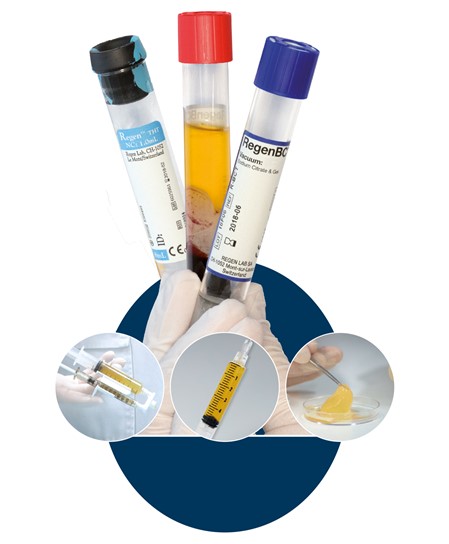RegenLab PRP Technology
RegenLab PRP Technology
Designed to be used for the safe and rapid preparation of autologous platelet rich plasma (PRP) from a small sample of blood at the patient's point-of-care. The PRP is mixed with autograft and/or allograft bone prior to application to a bony defect for improving handling characteristics. The kits are for single-use only.
Product Description
What is PRP?
Platelets are key factors in hard and soft tissue repair mechanisms. They provide the essential growth factors FGF, PDGF, TGF-ß, EGF, VEGF, and IGF that are involved in stem cell migration, differentiation and proliferation. The stimulation of fibroblasts and endothelial cells induces new extracellular matrix deposition and neo-vascularization.
Plasma is essential for cell survival as it contains nutrients, vitamins, hormones, electrolytes and proteins. Proteins are key molecules for the coagulation process and the formation of the fibrin polymer that will serve as a scaffold for cell migration, differentiation and proliferation.
Ideal Platelet Concentration
The Regen™-BCT tube prepares 5 to 6 ml of autologous platelet rich plasma with a platelet recovery greater than 80% and a concentration factor of 1.6-fold. Although the system is technically capable of producing significantly higher platelet concentrations, it is not what some research shows to be the most beneficial for clinical use. More and more studies demonstrate that concentrations of platelets 1 to 3 times over the baseline show more robust healing rates than those with concentrations of 3 to 8 times the baseline1.
Some studies even showed that too high platelet concentrations may actually have negative effects. In an in vivo study2, it was shown that highly concentrated platelet preparations had an inhibitory influence on osteoblast activity, probably due to unwanted inhibitory and cytotoxic effects of growth factors at such high concentrations. Similarly, an in vitro study3 demonstrated that platelet concentrations over 2.5-fold resulted in a reduction in proliferation and a suboptimal effect on osteoblast function.
Platelets are key factors in hard and soft tissue repair mechanisms. They provide the essential growth factors FGF, PDGF, TGF-ß, EGF, VEGF, and IGF that are involved in stem cell migration, differentiation and proliferation. The stimulation of fibroblasts and endothelial cells induces new extracellular matrix deposition and neo-vascularization.
Plasma is essential for cell survival as it contains nutrients, vitamins, hormones, electrolytes and proteins. Proteins are key molecules for the coagulation process and the formation of the fibrin polymer that will serve as a scaffold for cell migration, differentiation and proliferation.
Ideal Platelet Concentration
The Regen™-BCT tube prepares 5 to 6 ml of autologous platelet rich plasma with a platelet recovery greater than 80% and a concentration factor of 1.6-fold. Although the system is technically capable of producing significantly higher platelet concentrations, it is not what some research shows to be the most beneficial for clinical use. More and more studies demonstrate that concentrations of platelets 1 to 3 times over the baseline show more robust healing rates than those with concentrations of 3 to 8 times the baseline1.
Some studies even showed that too high platelet concentrations may actually have negative effects. In an in vivo study2, it was shown that highly concentrated platelet preparations had an inhibitory influence on osteoblast activity, probably due to unwanted inhibitory and cytotoxic effects of growth factors at such high concentrations. Similarly, an in vitro study3 demonstrated that platelet concentrations over 2.5-fold resulted in a reduction in proliferation and a suboptimal effect on osteoblast function.
